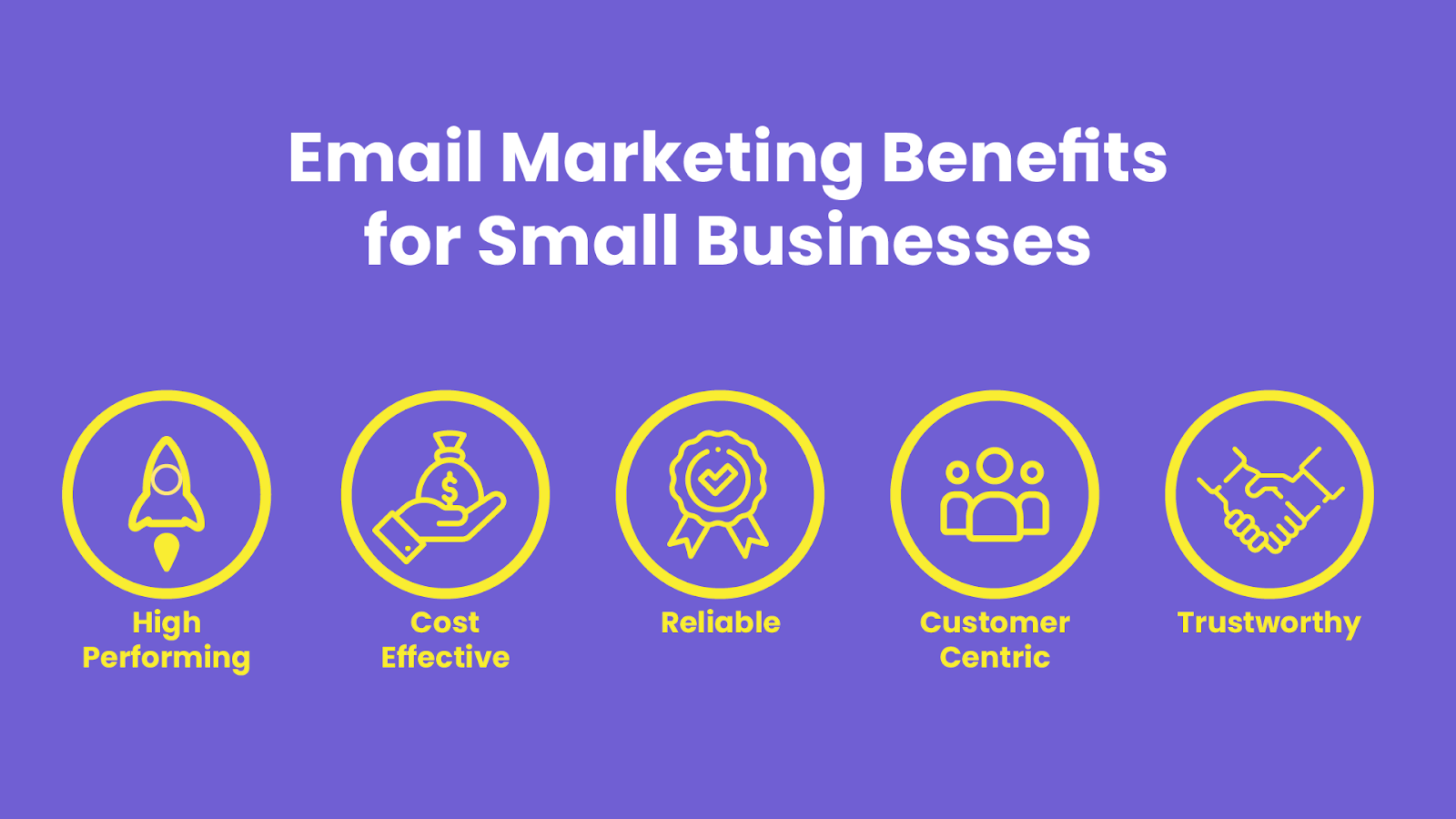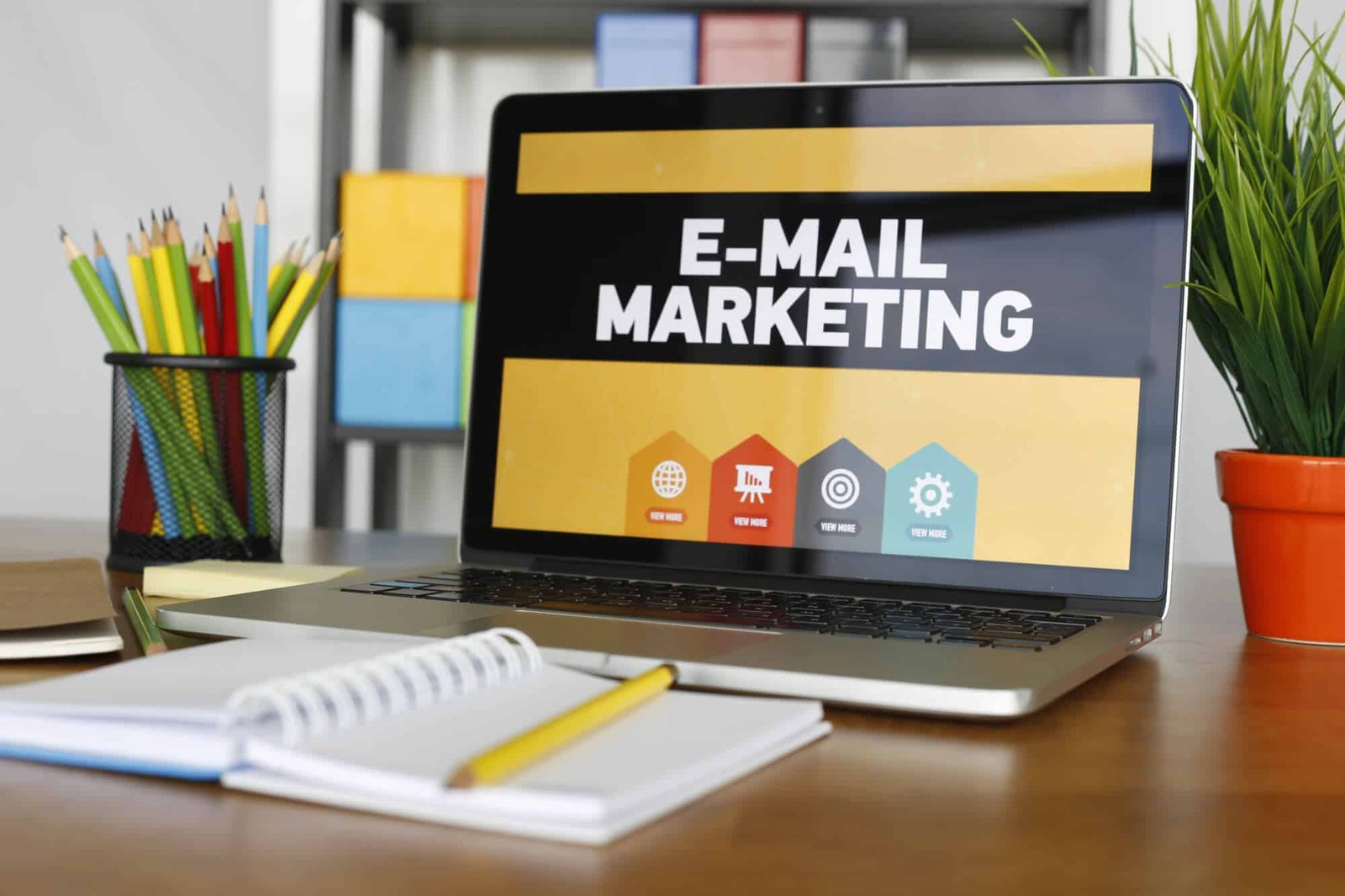Email marketing is a powerful tool for small businesses. It helps connect with customers and boost sales.
Small businesses often struggle to compete with larger companies. Limited budgets and resources make marketing a challenge. But email marketing offers an affordable and effective solution. With the right strategies, small businesses can reach their audience directly. Emails allow for personalized messages, building stronger customer relationships.
This method also provides measurable results, helping businesses see what works. In this blog post, we’ll explore the benefits and strategies of email marketing for small businesses. You’ll learn how to create effective campaigns that drive engagement and growth. Get ready to transform your marketing efforts and connect with your customers like never before.

Introduction To Email Marketing
Email marketing is a powerful tool for small businesses. It allows direct communication with customers. It is cost-effective and yields high returns. Understanding email marketing can help you grow your business.
Why Email Marketing Matters
Email marketing offers a direct line to your audience. Unlike social media, emails land in a personal inbox. This ensures your message gets seen. It helps build relationships with customers. You can share updates, promotions, and valuable content.
Emails can be personalized. This increases engagement and loyalty. You can segment your audience. Send targeted messages based on preferences and behavior. This leads to higher open and click-through rates.
Benefits For Small Businesses
| Benefit | Description |
|---|---|
| Cost-Effective | Email marketing is cheaper than traditional advertising. It offers a high return on investment. |
| Reach | You can reach a large audience. Emails can be sent to hundreds or thousands of subscribers. |
| Measurable | You can track your campaigns. Monitor open rates, click-through rates, and conversions. |
| Engagement | Emails drive customer engagement. Share valuable content, promote products, and offer discounts. |
| Personalization | Emails can be tailored to individual preferences. This improves relevance and response rates. |
Small businesses benefit greatly from email marketing. It helps build brand loyalty. It keeps your audience informed and engaged. Start leveraging email marketing today.
Building An Email List
Building an Email List is crucial for small businesses. It helps you reach your audience directly. You can share updates, promotions, and valuable content. But how do you build a strong email list? Let’s explore some effective strategies and tools to help you grow and manage your list.
Strategies To Grow Your List
Growing your email list requires strategic planning. Here are some effective methods:
- Offer Incentives: Provide discounts, free e-books, or exclusive content.
- Use Sign-Up Forms: Place forms on your website, blog, and social media pages.
- Create Engaging Content: Write blogs, articles, or newsletters that people want to read.
- Host Webinars: Invite people to webinars and collect their emails for registration.
- Leverage Social Media: Promote your email list on Facebook, Instagram, and Twitter.
Tools For List Management
Managing your email list is essential for effective email marketing. Here are some tools to help you:
| Tool | Features | Pricing |
|---|---|---|
| Mailchimp | Sign-up forms, automation, analytics | Free to premium plans |
| Constant Contact | Email templates, list segmentation, tracking | Free trial, then paid plans |
| AWeber | Autoresponders, email tracking, integrations | Free plan, then paid plans |
| ConvertKit | Landing pages, automation, tagging | Free to premium plans |
These tools help you organize, segment, and analyze your email list. This ensures you send the right message to the right people.
Building and managing an email list takes time and effort. But the rewards are worth it. With a strong email list, you can reach your audience and grow your business.
Creating Engaging Content
Email marketing offers a direct way to reach customers. Creating engaging content is key for small businesses. It helps build relationships and boosts conversions. Effective content captures attention and keeps readers interested. Let’s explore how to create such content.
Subject Lines That Work
The subject line is the first thing readers see. It needs to grab attention quickly. Here are some tips for crafting effective subject lines:
- Keep it short and to the point. Aim for 6-10 words.
- Use action words. They encourage readers to open the email.
- Personalize it. Use the recipient’s name or location.
- Include numbers or lists. They are easy to read and understand.
- Avoid spammy words. Words like “free” or “guarantee” can trigger spam filters.
Here are some examples of good subject lines:
| Subject Line | Reason |
|---|---|
| John, Your Special Discount Awaits! | Personalized and intriguing |
| 5 Tips to Boost Your Sales Today | Uses numbers and promises value |
| Last Chance to Save 20% | Creates urgency |
Crafting Compelling Messages
After the subject line, the message itself must hold attention. Here are some steps to craft compelling messages:
- Start with a strong opening: Use an interesting fact or question.
- Keep paragraphs short: Long paragraphs can be overwhelming.
- Use bullet points: They make the content easy to scan.
- Include a clear call to action: Tell readers what you want them to do next.
- Add visuals: Images or videos can make your message more engaging.
Here’s a sample structure for an engaging email message:
Subject Line: "Your Free Guide to Healthy Eating!" Opening: "Did you know that 70% of adults don't eat enough vegetables?" Body: "We want to help you change that. Our free guide offers simple tips to add more veggies to your diet. Here are a few highlights: - Easy recipes to try today - Tips for buying fresh produce - How to meal prep for the week Call to Action: "Download your free guide now!" Visuals: Add a colorful image of a healthy meal
Following these tips can help you create content that engages and converts.
Designing Effective Campaigns
Designing Effective Campaigns is crucial for the success of email marketing for small businesses. A well-designed campaign can capture attention, engage recipients, and drive action. This section will explore different types of email campaigns and offer design tips for high engagement.
Types Of Email Campaigns
Understanding the types of email campaigns can help you choose the right one for your business needs. Here are some common types:
- Welcome Emails: Introduce new subscribers to your brand.
- Promotional Emails: Highlight sales, discounts, or special offers.
- Newsletter Emails: Share updates, news, or valuable content.
- Transactional Emails: Confirm orders or provide receipts.
- Re-engagement Emails: Win back inactive subscribers.
Design Tips For High Engagement
Effective design can boost the engagement of your email campaigns. Follow these tips for the best results:
- Keep it Simple: Use a clean layout with plenty of white space.
- Mobile-Friendly Design: Ensure your emails look good on mobile devices.
- Eye-Catching Subject Lines: Craft compelling subject lines that entice recipients to open.
- Personalization: Use the recipient’s name and tailor content to their interests.
- Clear Call to Action (CTA): Make your CTA buttons prominent and easy to click.
- Visuals: Use high-quality images and graphics to make your email visually appealing.
- Consistent Branding: Match the email design with your brand’s colors and style.
- Readable Fonts: Choose fonts that are easy to read on all devices.
Here is a quick reference table for design elements:
| Element | Tip |
|---|---|
| Layout | Use a single-column layout for simplicity. |
| Images | Optimize images for fast loading. |
| CTA | Place CTAs above the fold. |
| Fonts | Use sans-serif fonts for better readability. |
Personalization And Segmentation
In the world of email marketing, personalization and segmentation are key. These techniques help small businesses connect with their audience. Personalized emails feel more genuine. Segmented lists ensure the right content reaches the right people. This leads to better engagement and higher conversion rates.
Understanding Your Audience
Knowing your audience is the first step. You must understand their needs and preferences. Collect data through surveys, website analytics, and social media. Use this information to create detailed customer profiles.
These profiles help you understand who your customers are. What are their interests? What problems do they face? What solutions are they looking for? Answering these questions helps you create personalized content.
How To Segment Your List
Segmentation involves dividing your email list into smaller groups. Each group shares common traits. This allows you to send targeted messages to each group. Here are some ways to segment your list:
- Demographic Information: Age, gender, location, etc.
- Behavioral Data: Purchase history, website activity, email engagement.
- Interests and Preferences: Topics they like, products they view or buy.
Use these segments to create tailored content. For example, send product recommendations based on past purchases. Share blog posts related to their interests. This increases the chances of engagement.
Here’s a simple table to illustrate segmentation:
| Segment | Criteria | Example Content |
|---|---|---|
| Young Professionals | Age 25-35, Urban areas | Career tips, Work-life balance advice |
| Parents | Has children, Suburban areas | Parenting tips, Family activities |
| Fitness Enthusiasts | Engages with fitness content | Workout plans, Nutrition guides |
By personalizing your emails and segmenting your list, you can create more relevant and engaging content. This not only improves your open and click-through rates but also builds trust with your audience.

Automation And Workflows
Email marketing can be a powerful tool for small businesses. To maximize its potential, automation and workflows are crucial. Automation saves time and ensures consistency. Workflows guide the customer journey. They turn leads into loyal customers.
Setting Up Automated Emails
First, choose an email marketing platform. Popular options include Mailchimp, SendinBlue, and Constant Contact. Next, create a list of your subscribers. Group them based on their interests and behavior. This helps you send targeted emails.
After that, design your automated emails. Use templates provided by your platform. Customize them with your brand colors and logo. Keep the content simple and clear. Use bold text for important points. Include a call to action in each email.
Finally, set triggers for your automated emails. Triggers are actions that start the automation. Common triggers include:
- New subscriber joins your list
- Customer makes a purchase
- Subscriber clicks on a link
Examples Of Effective Workflows
Workflows help guide your customers through different stages. Here are some examples:
| Workflow | Description |
|---|---|
| Welcome Series | Send a series of emails to new subscribers. Introduce your brand. Offer a discount. |
| Abandoned Cart | Remind customers of items left in their cart. Offer an incentive to complete the purchase. |
| Re-Engagement | Reach out to inactive subscribers. Offer something valuable to re-engage them. |
These workflows ensure you stay connected with your customers. They help you build strong relationships.
Remember to monitor your campaigns. Use analytics to see what works best. Adjust your strategies based on the data. This way, you make the most out of your email marketing efforts.
Analyzing Campaign Performance
Email marketing can be a powerful tool for small businesses. But to maximize its effectiveness, you need to analyze your campaign performance. Understanding the results helps you refine your approach and achieve better outcomes.
Key Metrics To Track
To determine the success of your email campaigns, track these key metrics:
- Open Rate: The percentage of recipients who open your email.
- Click-Through Rate (CTR): The percentage of recipients who click on a link within your email.
- Conversion Rate: The percentage of recipients who take a desired action, like making a purchase or filling out a form.
- Bounce Rate: The percentage of emails that could not be delivered.
- Unsubscribe Rate: The percentage of recipients who opt out of your email list after receiving a campaign.
Tracking these metrics provides insights into your audience’s behavior. It helps you understand what works and what needs improvement.
Using Data To Improve Campaigns
Analyzing data allows you to make informed decisions. Here’s how to use this data to improve your campaigns:
- Identify Patterns: Look for trends in your open and click-through rates. Determine which types of content and subject lines resonate most with your audience.
- Test and Optimize: Use A/B testing to try different email elements. Compare performance and optimize based on the results.
- Segment Your Audience: Divide your email list into smaller segments based on behavior or demographics. Tailor your messages to each segment for better engagement.
- Monitor Bounce and Unsubscribe Rates: A high bounce rate can indicate issues with your email list. High unsubscribe rates may signal that your content is not meeting expectations.
Using these strategies, you can continuously improve your email marketing campaigns. This leads to better engagement and higher conversion rates.
Compliance And Best Practices
Email marketing is a powerful tool for small businesses. To use it effectively, understanding compliance and best practices is essential. This ensures your emails reach the right audience and adhere to legal standards. Below, we explore key compliance rules and best practices for maintaining a healthy email list.
Understanding Gdpr And Can-spam
GDPR and CAN-SPAM are vital regulations for email marketing. The General Data Protection Regulation (GDPR) protects the privacy of individuals in the European Union. It requires businesses to obtain explicit consent before sending marketing emails.
CAN-SPAM stands for the Controlling the Assault of Non-Solicited Pornography And Marketing Act. It governs email marketing in the United States. This act requires businesses to include a clear way to unsubscribe in every email.
| Regulation | Region | Key Requirements |
|---|---|---|
| GDPR | European Union | Explicit consent, data protection |
| CAN-SPAM | United States | Unsubscribe option, accurate header |
Maintaining List Health
Maintaining a healthy email list is crucial for successful email marketing. It ensures your emails reach engaged recipients. Follow these best practices to keep your list healthy:
- Regularly clean your list by removing inactive subscribers.
- Use double opt-in to confirm subscriber interest.
- Segment your list to send targeted content.
- Monitor email metrics like open rates and click-through rates.
Regularly cleaning your email list removes uninterested contacts. This improves deliverability and engagement. Double opt-in ensures subscribers genuinely want to hear from you. Segmentation allows for more personalized and relevant content. Monitoring metrics helps identify trends and improve your strategy.
Case Studies And Success Stories
Small businesses often wonder if email marketing is worth the effort. The answer is yes. Below, we share case studies and success stories. These examples demonstrate how small businesses have used email marketing effectively.
Small Business Success Examples
Here are a few small businesses that have seen great results:
- Bakery Delight: This local bakery saw a 40% increase in sales. They used email newsletters to promote weekly specials and new products.
- Fitness Pro: A small gym increased membership sign-ups by 25%. Their strategy involved sending personalized fitness tips and promotional offers.
- Crafty Creations: This handmade crafts store doubled its online sales. They used segmented email lists to target different customer interests.
Lessons Learned From Case Studies
These success stories teach us valuable lessons:
- Consistency is Key: Regular email updates keep your audience engaged. Bakery Delight sent weekly newsletters without fail.
- Personalization Works: Tailoring content to your audience increases engagement. Fitness Pro’s personalized tips made their emails more relevant.
- Segmentation Boosts Sales: Dividing your email list into segments helps target specific interests. Crafty Creations used this to their advantage and saw great results.
By following these lessons, small businesses can achieve similar success. Consistency, personalization, and segmentation are crucial. Use these strategies and watch your email marketing efforts pay off.

Future Of Email Marketing
The future of email marketing for small businesses is bright. With evolving technology, email marketing is becoming more personalized and efficient. Small businesses can leverage these changes to create more engaging campaigns. Let’s explore some key trends and innovative techniques shaping the future of email marketing.
Trends To Watch
Stay ahead by watching these trends:
- Artificial Intelligence (AI): AI helps in personalizing content. It can suggest the best times to send emails and predict customer behavior.
- Interactive Emails: Interactive elements like surveys, polls, and videos engage recipients more effectively.
- Mobile Optimization: With more users accessing emails on mobile devices, optimizing emails for mobile is crucial.
- Automation: Automated email sequences save time and ensure timely communication.
Innovative Techniques
Implement these techniques to stay competitive:
- Segmentation: Group your email list based on demographics, purchase history, and behavior. Send targeted emails to each segment.
- Personalization: Use recipient names, preferences, and past interactions to create personalized messages.
- Dynamic Content: Include content that changes based on the recipient’s behavior or preferences.
- A/B Testing: Test different subject lines, content, and send times to find what works best for your audience.
Consider these trends and techniques for a successful email marketing strategy. Small businesses can achieve higher engagement and conversion rates by adapting to the future of email marketing.
Frequently Asked Questions
What Is Email Marketing For Small Businesses?
Email marketing is a strategy where small businesses send emails to customers. These emails aim to promote products, build relationships, and boost sales.
How Can Email Marketing Benefit Small Businesses?
Email marketing helps small businesses reach customers directly. It increases brand awareness, drives sales, and builds customer loyalty.
What Are The Best Email Marketing Tools For Small Businesses?
Popular tools include Mailchimp, Constant Contact, and Sendinblue. These platforms offer user-friendly features and affordable plans.
How Often Should Small Businesses Send Marketing Emails?
Small businesses should send marketing emails regularly but not too frequently. Typically, sending once a week is effective.
Conclusion
Email marketing offers many benefits for small businesses. It is cost-effective and reaches a wide audience. Building strong relationships with customers becomes easy. Personalized messages can increase engagement and sales. Track your results to improve future campaigns. Start small, learn, and grow your email marketing strategy.
Success comes with time and effort. Stay consistent and see the rewards. Happy emailing!



Leave a Reply